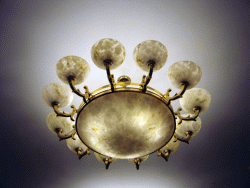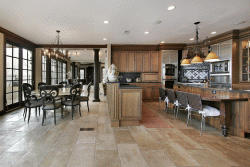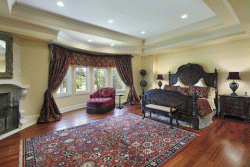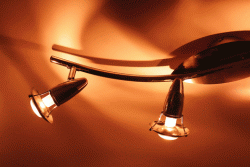Ceiling Lighting Fixtures: Choose the Ceiling Lights That Suit Your Style
There are a number of ceiling lighting fixtures available that will suit any type of design.
Choosing ceiling lighting fixtures is one of the most important decisions in any lighting design. Not only are they a highly visible decoration on your ceiling, they are also a key component of the quality of light throughout your entire room. On top of this, ceiling lighting can be awkward and often expensive to change, so any decision must be made with care.
Fortunately, there is a wide array of ceiling lighting fixtures available for sale on the market today. These differ not only in their appearance, but in the quality of the light that they cast on your furniture and on your guests and family. In fact, the sheer number of options available can seem overwhelming…to the point where people often make the mistake of throwing up the first lighting suggested to them.
Nonetheless, choosing the right lighting is simply a matter of understanding what the various types of ceiling lighting fixtures are and how they are different. Once you understand that, you’ll be able to make practical choices about the type of lighting you want before you invest the money in expensive and difficult-to-change fixtures.
Pendant Lights

The more light a pendant shines on the ceiling, the more it helps generate ambient light and the less of a glare bomb it is.
First, more than with any other form of ceiling lighting, you should consider the appearance of the actual fixtures themselves. Pendant lights by design are highly visible, and they should be treated as a form of decoration in addition to being a light source.
So, you should make sure that pendant lights are similar in style to the other furniture in your room. However, don’t just match your pendant lights to your current furniture. Unless you plan to change your pendant lighting every few years, you should make sure that your pendant lighting will match future furniture choices as well. Choose fixtures that are sufficiently neutral that they can adapt to any changes that you will make in the room’s décor.

Multiple types of ceiling lighting fixtures can work together to create the right mixture of lighting quality.
Instead, pendants can be used for three different things:
- First, they can be used simply as decorative lighting. In this case, the pendant only seems to light the room, while the actual lighting work is done by wall fixtures, other ceiling fixtures or lamps. This is usually the best approach when you have a single attractive pendant. Use low wattage bulbs (such as 12V light bulbs) so that is decorative, but not a true light source.
- Second, they can be used to light important areas within the room. Normally, this would be done using multiple pendants in the same area, such as a collection of pendant lights used in the dining area of a kitchen. Using diffuse shades, you can create warm lights on the face of guests that can offset the harsher shadows cast by recessed lighting fixtures.
- Finally, they can be used to create diffuse light. If you are using a single pendant and want it to be a true light source, consider shining the light upward onto the ceiling, allowing the reflected light to fill the room. For this to work, the light would need to have an opaque or heavily translucent downward shade, ideally with a reflective or white interior. This light can supplement the light in your room without creating a glare bomb.
Pendant lighting can be used either decoratively or to create ambient lighting. Which will look better depends on the type of ceiling lighting fixtures that are used.
Recessed Lighting
One of the most common types of ceiling lighting is recessed lighting. In recessed lighting, holes are created in the ceiling and the lights are “recessed” into those holes. The light from these fixtures has its own peculiar character, as it lights straight downward, leading to shadows that much be offset.

Recessed lights provide overall illumination, while the lamps offset any harsh shadows.
Recessed lighting is especially well-suited to rooms with permanent furniture or fixtures. For example, recessed lighting can be a great fit in kitchens or bathrooms where the fixtures and appliances rarely move around, and you can plan the lighting around them. On the other hand, recessed lighting is often a poor fit in living rooms or even dining rooms, where furniture is often moved.
The difficulty with the quality of recessed lighting is that the light is exclusively downward lighting. It cannot even really be reflected off of anything for ambient lighting. As a result, the light can create harsh shadows on people’s faces, aging them by increasing the apparent depth of their wrinkles. It also should almost never be used as task lighting, as people will cast shadows on their own work, forcing them to dodge their own shadows.
Fortunately, the issue with facial lighting can be easily offset. All you need to do is add other sources of illumination. Wall lighting or lamps are especially good for this. They can create diffuse light that hits people’s faces from below, countering both the angle and the harshness of the recessed ceiling lighting fixtures.
Recessed lighting is a great way of illuminating the entire room. The trick is to ensure that you’ve taken into account the shadowy quality of the light.
Track Lighting
Another popular choice in ceiling lighting fixtures is track lighting fixtures. Track lighting includes a number of lighting fixtures that are placed on an electrified track across your ceiling. The upside of these lights is that they are especially flexible. The light fixtures can be moved around depending on what is needed and even replaced entirely by compatible fixtures. This enables you to easily rearrange your room while keeping an appropriate lighting arrangement.

Track lighting fixtures can be easily moved so that they can illuminate different areas of your room.
Most track lighting is spot lighting using reflective bulbs such as halogen reflectors. Halogen reflectors are halogen lights that have a reflective surface on the back, strengthening their beam in a single direction. The reason for this has to do with the history of track lighting. Track lighting was originally developed by museums and art galleries, so that they could reposition lights depending on what was needed for shows. (If you don’t like the appearance of track lighting, another option is a cable lighting system).
As a result, track lighting is still the best source of what is called “accent lighting”. This is lighting that highlights individual details of your rooms. For example, you could use accent lighting to highlight artwork, attractive curtains, a clock or anything else you want to “accent” in your room. This light then bounces off of the object and the walls, contributing to your overall level of ambient lighting.
The problem with too much accent lighting is the “museum effect” mentioned above. All that people can see is the individual objects that you have highlighted. Because of this, track accent lighting should never be your main source of lighting in the room.
Putting It All Together
There are a number of different choices for ceiling lighting fixtures within your home, and each has its own character, depending on your needs:
- Pendant lighting lights faces well, but creates the danger of a “glare bomb” if overtaxed.
- Recessed lighting fills the room with light, but needs to be offset to prevent unflattering shadows.
- Track lighting provides quality, flexible accent lighting, but can make your house look like a museum if used too heavily.
Note that even this list does not exhaust the options, as you might consider different systems like low-voltage cable lighting systems. With all of these considerations in mind, it should be easier to choose just the right ceiling lighting fixtures for your home.
More Ceiling Lighting Articles:
Cable Lighting System: Cable Light Fixtures and How to Use Them
A cable lighting system provides flexible light across uneven ceilings.
Low-Voltage Cable Lighting: Choosing Transformers and Fixtures
Low-voltage cable lighting allows you to create highly-focused accent lighting for your home.
Cathedral Ceiling Lighting: Architectural Detail and Design Challenges
Cathedral ceiling lighting can be challenging, but when done well can provide quality lighting and accent your architectural design.
Contemporary Ceiling Lighting: Minimalism, Modernism, Functionalism and More
Contemporary ceiling provides a wide range of new functional and stylistic options.
Modern Pendant Lighting: Contemporary Chandeliers and other Pendants
Modern pendant lighting offers many options featuring geometric shapes and new materials.